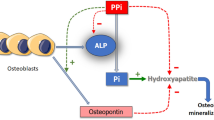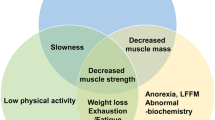Summary
Determination of total and ionized serum calcium and of calcium/creatine ratio in urine collected over a 24 h period and in urine obtained in the morning after an overnight fast was performed in 38 patients with untreated sarcoidosis and a control-group of 33 healthy volunteers. In all patients with hypercalciuria abdominal x-ray in supine position was performed and in addition an intravenous urogram in those cases with a history of renal stone disease and/or renal colic. Mild hypercalcemia was only found in 3 (7.9%) of 38 patients with sarcoidosis. In 24 patients with repeated calcium determinations whole serum calcium was at times moderately elevated (>10.2 mg%) in 8 patients (33%). Elevation of ionized serum calcium was detected in 10 (27.8%) of 36 patients. In these patients mean ionized calcium concentration was significantly higher (p<0.05) than in normal controls (4.56±0.25 mg% vs. 4.45±0.13 mg%). 20 patients (52.6%) showed an elevated urinary calcium/creatinine ratio (>0.15). Calcium/creatinine ratios were significantly higher (p<0.001) in patients with sarcoidosis than in controls (0.15±0.05 vs. 0.10±0.04). Determination of calcium/creatinine ratio both in 24 h urine and in urine collected in the morning after an overnight fast showed that 12 patients were intestinal calcium hyperabsorbers, whereas 8 patients had increased mobilisation of bone calcium. Renal stone disease was found in only 3 patients (7.9%) with hypercalciuria. Our results indicate that increased calcium release from bone or intestinal hyperabsorption of calcium are responsible for the disturbed calcium metabolism in sarcoidosis. Since vitamin D metabolites have been reported to be normal in patients with sarcoidosis, intestinal calcium hyperabsorption and increased mobilisation of bone calcium may be explained by an increased and individually different sensitivity of the target organs bone and gut to vitamin D in sarcoidosis.
Zusammenfassung
Bei 38 Patienten mit unbehandelter Sarkoidose und 33 Kontrollpersonen erfolgte die Bestimmung von Gesamtcalcium und ionisiertem Calcium im Serum und des Calcium/Kreatinin-Quotienten im 24 h- und Morgenurin. Bei allen hypercalciurischen Patienten wurde eine Abdomenleeraufnahme, bei Patienten mit Stein- oder Kolikanamnese ein i.v.-Urogramm angefertigt. Bei Analyse der aktuellen Serumcalciumbestimmungen fand sich bei 3 (7,9%) von 38 Patienten eine Hypercalcämie. Bei Mitbeurteilung von Serumcalciumbestimmungen in der vorausgegangenen Kontrollperiode zeigten allerdings 8 (33%) von 24 untersuchten Patienten zuweilen eine geringgradige klinisch nicht relevante Erhöhung des Gesamtcalciums. Die ionisierte Calciumfraktion war bei 10 (27,8%) von 36 untersuchten Sarkoidosepatienten erhöht. Die mittlere Konzentration des ionisierten Serumcalciums lag bei den Sarkoidosepatienten signifikant höher (p<0,05) als in der Kontrollgruppe (4,56±0,25 mg-% vs 4,45±0,13 mg-%). Als häufigste Calciumstoffwechselstörung fand sich bei 20 Patienten (52,6%) eine Hypercalciurie (Calcium/Kreatinin-Quotient >0,15 im 24 h-Urin). Der Calcium/Kreatinin-Quotient war bei den Sarkoidosepatienten significant höher (p<0,001) als in der Kontrollgruppe (0,15±0,05 vs. 0,10±0,04). Anhand der Bestimmung des gleichen Quotienten im Morgenurin nach einer 10stündigen Fastenperiode erfolgte die pathogenetische Aufschlüsselung der Hypercalciurie: Bei 12 Patienten ist eine intestinal-absorptive Form und bei 8 Patienten eine ossär-resorptive Form der Hypercalciurie anzunehmen. Nur bei 3 Patienten (7,9%) mit Hypercalciurie fand sich eine Urolithiasis. Unsere Ergebnisse zeigen, daß eine vermehrte Calciumfreisetzung aus den Knochen oder eine intestinale Calcium-Hyperabsorption für den gestörten Calciumstoffwechsel bei Sarkoidose verantwortlich sind. Da die in der Literatur angegebenen Messwerte der Vitamin-D-Metaboliten bei Sarkoidosepatienten Normalwerte ergeben, muß eine individuell unterschiedliche Sensitivitätszunahme der Zielorgane des Vitamin D Darm und Knochen als Ursache der Calciumstoffwechselstörungen bei Sarkoidosepatienten postuliert werden.
Similar content being viewed by others
Literatur
Anderson, J., Dent, C., Harper, C., Philpot, G.: Effect of cortisone on calcium metabolism in sarcoidosis with hypercalcemia: Possible antagonistic actions of cortisone and Vitamin D. Lancet2, 720 (1954)
Basset, G.: Les désordres humoraux dans la sarcoidose. Bull. Mem. Soc. Med. Hop. de Paris115, 583 (1964)
Bell, N.H., Bartter, F.C.: Studies of 47-Ca metabolism in sarcoidosis: evidence for increased sensitivity of bone to vitamin D. Acta Endocrinol.54, 173 (1967)
Bell, N., Gill, J., Bartter, F.: On abnormal calcium absorption in sarcoidosis: Evidence for increased sensitivity to Vitamin D. Am. J. Med.36, 500 (1964)
Cantwell, D.: Sarcoidosis, with renal involvement. Irish J. Med. Sc.6, 223 (1954)
Cushard, W. Jr., Simon, A., Canterbury, J., Reiss, E.: Parathyroid function in sarcoidosis. New Engl. J. Med.286, 395 (1972)
Davidson, Ch., Dennis, J., McNinch, E., Willson, J., Brown, W.: Nephrocalcinosis associated with sarcoidosis: A presentation and discussion of seven cases. Radiology62, 203 (1954)
Dent, C.: The effect of cortisone on calcium metabolism in sarcoidosis and other vitamin D sensitive states. In: Proceedings of the eithth Middle East Medical Assembly, American University of Beirut, p. 162. Beirut, Lebanon, 1958
Dent, C., Watson, L.: Hyperparathyroidism and sarcoidosis. Br. Med. J.1, 646 (1966)
Diagnosis of pulmonary sarcoidosis. Br. Med. J.4, 540 (1975)
Fanconi, G.: Variations in sensitivity to Vitamin D: from Vitamin D resistant rickets, Vitamin D avitaminotic rickets and hypervitaminosis D to idiopathic hypercalcemia. In: Ciba Foundation Symposium on Bone Structure and Metabolism (Wolstenholme, G.E.W., O'Connor, C.M., eds.), p. 187. Boston: Little, Brown and Co. 1956
Goldstein, R., Israel, H., Becker, K., Moore, Ch.: The infrequency of hypercalcemia in sarcoidosis. Am. J. Med.51, 21 (1971)
Hahnemann, S., Transbøl, I., Hornum, I.: The serum calcium fractions in hypercalcemic sarcoidosis with and without hyperparathyroidism. La sarcoidose. Rapports de la IVe conférence Internationale (Turiaf, J., Chabot, J., eds.), p. 605. Paris: Masson et Cie 1967
Harell, G., Fisher, S.: Blood chemical changes in Boeck's sarcoid with particular reference to protein, calcium and phosphate values. J. Clin. Invest.18, 687 (1939)
Hartmann, F., Lehmann, H.: Gleichzeitiges Vorkommen einer Sarkoidose und eines autonomen Hyperparathyreoidismus, Zufall oder Folge? Med. Klin.70, 904 (1975)
Hendrix, J.Z.: Abnormal skeletal mineral metabolism in sarcoidosis. Ann. Int. Med.64, 797 (1966)
Hendrix, J.Z.: Calcium, magnesium, and phosphorus metabolism in sarcoidosis. Clin. Res.12, 270 (1964)
Hendrix, J.Z.: Remission of hypercalcemia and hypercalcuria in sarcoidosis by vitamin D depletion. Clin. Res.11, 220 (1963)
Hendrix, J.Z.: Sarcoidosis and bone mineral metabolism. Clin. Res.12, 457 (1964)
Henneman, P., Dempsey, E., Caroll, E., Albright, F.: Cause of hypercalciuria in sarcoid and its treatment with cortisone and sodium phytate. J. Clin. Invest.35, 1229 (1956)
Hornum, I., Transbøl, I.: Observations on the different calcium metabolic patterns in sarcoidosis. Acta Med. Scand.200, 341 (1976)
Hunt, B.J., Yendt, E.R.: Response of hypercalcemia in sarcoidosis to chloriquine. Ann. Int. Med.59, 554 (1963)
Israel, H., Sones, M.: Sarcoidosis. Clinical observation on one hundred sixty cases. Arch. Int. Med.102, 766 (1958)
Jackson, W., Dancaster, C.: Consideration of hypercalciuria in sarcoidosis, idiopathic hypercalciuria and that produced by Vitamin D; New suggestion regarding calcium metabolism. J. Clin. Endocrinol.19, 658 (1959)
Jackson, W.P.U., Dancaster, C.: Observations on effects of vitamin D in man, including relation to cortisone. J. Clin. Endocrinol. Metabol.22, 195 (1962)
James, D.: Diagnosis and treatment of ocular sarcoidosis. Acta Med. Scand.176, 203 (1964)
Klatskin, G., Gordon, M.: Renal complications of sarcoidosis and their relationship to hypercalcemia. Am. J. Med.15, 484 (1953)
Larson, L., Liljestrand, A., Wahlund, H.: Treatment of sarcoidosis with calciferol. Acta Med. Scand.143, 280 (1952)
Lebacq, E., Henrich, H., Mayeur, S.: Hypercalciuria in sarcoidosis. Z. Erkrank. Atm.-Org.149, 219 (1977)
Longcope, T., Freiman, D.: Study of sarcoidosis. Medicine31, 1 (1952)
Mather, G.: Calcium metabolism and bone changes in sarcoidosis. Br. Med. J.1, 248 (1957)
Mawer, E.B., Backhouse, J., Lumb, G.A., Stanbury, S.W.: Evidence for formation of 1,25-dihydroxycholecalciferol during metabolism of vitamin D in man. Nature New Biol.232, 188 (1971)
Maycock, R., Bertrand, P., Morrison, C., Scott, J.: Manifestations of sarcoidosis. Analysis of 145 patients, with a review of nine series selected from the literature. Am. J. Med.35, 67 (1963)
Murphy, G., Schirmer, H.: Nephrocalcinosis, urolithiasis and renal insufficiency in sarcoidosis. J. Urol.86, 702 (1961)
Nordin, B., Peacock, M.: Hypercalciuria. In: Urinary Calculi. Delatte, C., Rapado, A., Hodgkinson, A., eds.). Basel: S. Karger 1973
Pak, Ch., Kaplan, R., Bone, H., Townsend, J., Waters, O.: A simple test for the diagnosis of absorptive, resorptive and renal hypercalciurias. New Engl. J. Med.292, 497 (1975)
Prasad, A., Flink, E.: The determination of ultrafiltrable calcium in a variety of clinical conditions. J. Lab. Clin. Med.52, 1 (1958)
Putkonen, T., Hannuksela, M., Halme, H.: Calcium and phosphorus metabolism in sarcoidosis. Acta Med. Scand.177, 327 (1965)
Reiner, M., Sigurdsson, G., Nunziata, V., Malik, M., Poole, G., Joplin, G.: Abnormal calcium metabolism in normocalcemic sarcoidosis. Br. Med. J.2, 1473 (1976)
Scadding, J.: Sarcoidosis, with special reference to lung changes (Bradshaw lecture). Br. Med. J.1, 745 (1950)
Scholz, D., Keating, F.: Renal insufficiency, renal calculi and nephrocalcinosis in sarcoidosis. Am. J. Med.21, 75 (1956)
Smith, M., Hey, G.: Recurring red eyes due to seasonal hypercalcemia. Postgrad. Med. J.52, 86 (1976)
Taylor, R., Lynch, H., Wysor, W. Jr.: Seasonal influence of sunlight on hypercalcemia of sarcoidosis. Am. J. Med.34, 221 (1963)
Terepka, A., Toribara, T., Dewey, P.: The ultrafiltrable calcium of human serum. Il. Variations in disease states and under experimental conditions. J. Clin. Invest.37, 87 (1958)
Tervonen, S., Karjalainen, P., Valta, R.: Bone mineral in sarcoidosis. Acta Med. Scand.196, 497 (1974)
Winnacker, J., Becker, K., Friedlander, M., Higgins, G. Jr., Moore, C.F.: Sarcoidosis and hyperparathyroidism. Am. J. Med.46, 305 (1969)
Winnacker, J., Becker, K., Katz, S.: Endocrine aspects of sarcoidosis. New Engl. J. Med.278, 427 (1968)
Winterbauer, R., Belic, N., Moores, K.: A clinical interpretation of bilateral hilar adenopathy. Ann. Int. Med.78, 65 (1973)
Wurm, K., Reindell, H., Heilmeyer, L.: Lungenboeck im Röntgenbild. Stuttgart: Thieme 1958
Author information
Authors and Affiliations
Rights and permissions
About this article
Cite this article
Kuhlmann, U., Finkel, K., Binswanger, U. et al. Calciumstoffwechselstörungen bei Sarkoidose Inzidenz, Ausmass, Pathogenese und renale Folgeerkrankungen. Klin Wochenschr 58, 17–23 (1980). https://doi.org/10.1007/BF01477139
Received:
Accepted:
Issue Date:
DOI: https://doi.org/10.1007/BF01477139




